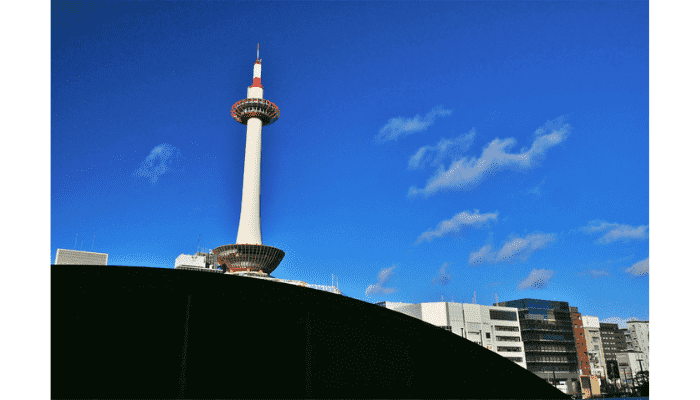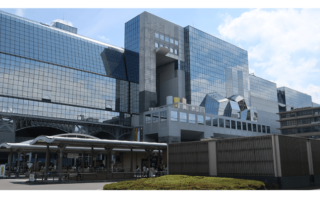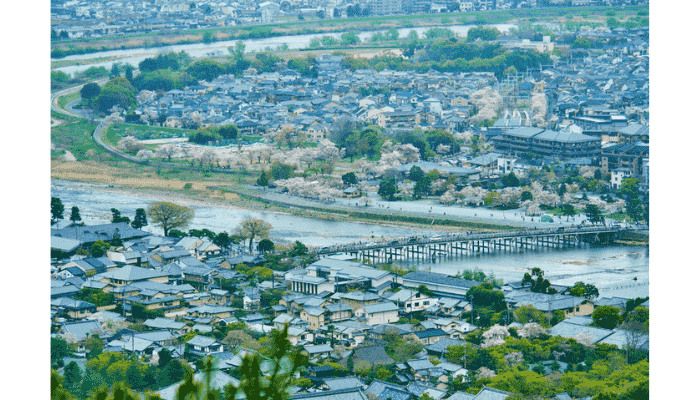Introduction
Planning your first trip to Kyoto? With its rich history, beautiful temples, and traditional streets, Kyoto offers countless sights to explore. But with so many options, it can feel overwhelming.
This guide introduces 10 must-visit spots, carefully selected for first-time visitors. Start with the essentials and experience the very best Kyoto has to offer!
Must-See Spots for First-Time Visitors
1. Fushimi Inari Taisha – Explore Kyoto’s Famous Red Torii Gates

Fushimi Inari Taisha is the head shrine of more than 30,000 Inari shrines throughout Japan.
A basic visit doesn’t take much time, but if you plan to hike the full pilgrimage route up Mount Inari, it will take around 90 minutes. Be prepared for a bit of a workout!
Since the hike is similar to climbing a small mountain, it’s best to wear sneakers and comfortable clothes suitable for walking.

“Inari” refers to Ukanomitama no Kami, the Shinto deity of rice, agriculture, and food. The white fox, believed to be the messenger of this deity, is a common symbol, so you’ll often see white fox motifs at Fushimi Inari Taisha—even the ema (wooden prayer plaques) are shaped like fox faces.
Each ema is decorated with unique drawings or wishes, making it fun to look at them. They’re full of personality and creativity!
But the biggest highlight of Fushimi Inari Taisha is undoubtedly the Senbon Torii, or “Thousand Torii Gates.”
In fact, nearly 10,000 bright red torii gates have been donated and line the pathways of the shrine grounds.

Most visitors come to see these iconic torii gates. Because it’s such a popular spot, it’s usually crowded, and taking photos without anyone in the frame can be quite a challenge—it requires patience!
If you want to enjoy a quieter experience or take clear photos, your best bet is to visit early in the morning or on a rainy day.
Fushimi Inari Taisha
- Address: 68 Fukakusa Yabunouchi-cho, Fushimi-ku, Kyoto, Japan
- Map: [Google Maps]
- Access:
・Right next to JR Nara Line’s Inari Station
・5-minute walk from Fushimi Inari Station on the Keihan Main Line - Phone: 075-641-7331
- Visiting Hours:
・Shrine grounds: Open 24 hours
・Prayer ceremonies: 8:30 AM – 4:30 PM (Reception until around 4:00 PM)
・Amulets & charms: 8:00 AM – 5:30 PM - Admission: Free
- Official Website: Fushimi Inari Taisha
2. Kinkaku-ji (Golden Pavilion) – See the Shimmering Golden Temple
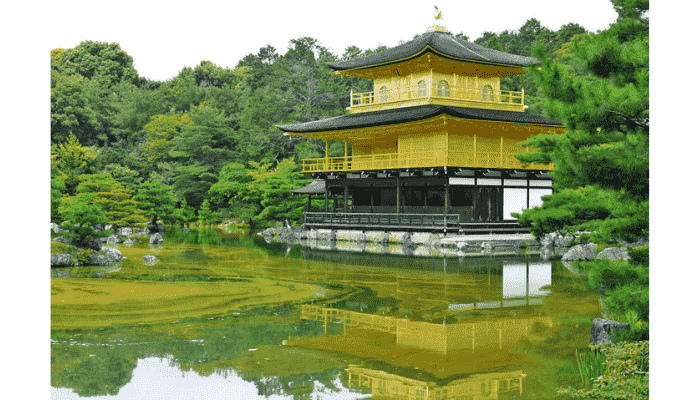
When it comes to the most eye-catching temple in Kyoto—or perhaps all of Japan—Kinkaku-ji, the Golden Pavilion, is hard to beat.
Famous from school textbooks and travel guides alike, this golden temple never fails to impress. No matter how many times you visit, its brilliance is always breathtaking.
One of the best seasons to visit Kinkaku-ji is winter. The contrast between the temple’s gold leaf exterior and the snow-covered landscape creates a magical scene that captivates visitors. It’s no surprise that Kinkaku-ji has gained worldwide attention as one of Japan’s most iconic landmarks.

Kinkaku-ji was originally built by Ashikaga Yoshimitsu, the third shogun of the Muromachi shogunate. Interestingly, it wasn’t a temple at first—it was his luxurious retirement villa. After his death, the villa was converted into a Zen temple.
By the way, “Kinkaku-ji” is actually a nickname. Its official name is Rokuon-ji (鹿苑寺), which means “Deer Garden Temple.”
Unfortunately, the original structure was lost in a fire caused by arson in 1950. This incident inspired the famous novel The Temple of the Golden Pavilion by Yukio Mishima.
Kinkaku-ji (Golden Pavilion)
- Address: 1 Kinkakuji-cho, Kita-ku, Kyoto, Japan
- Map: [Google Maps]
- Access: Take the Kyoto City Bus and get off at Kinkakuji-michi bus stop
- Phone: 075-461-0013
- Closed: Open year-round
- Opening Hours: 9:00 AM – 5:00 PM
- Admission:
・Adults (high school students and older): ¥500 (as of April 1, 2023)
・Elementary & junior high school students: ¥300 - Official Website: Kinkaku-ji
3. Arashiyama Bamboo Grove – Walk Through a Magical Forest
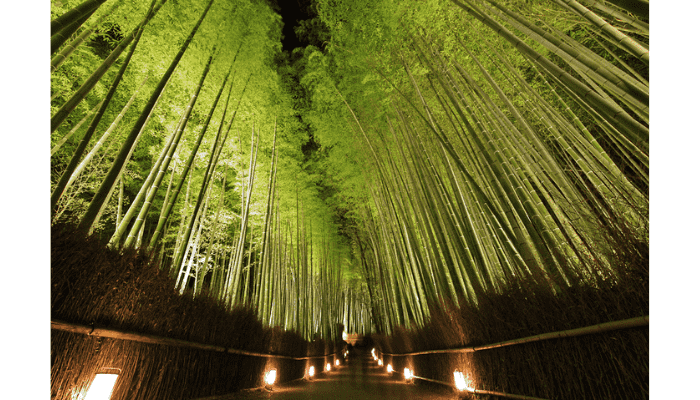
This enchanting 200-meter path connects Nonomiya Shrine to the Okochi Sanso Villa Garden.
Lush green bamboo lines both sides of the trail, stretching so high they seem to touch the sky, creating a natural canopy overhead.
The path lies in the heart of Arashiyama, one of Kyoto’s most scenic areas. Nearby, you’ll find other famous landmarks such as Tenryu-ji Temple and the iconic Togetsukyo Bridge. Surrounded by mountains and rivers, the entire area offers a calm, peaceful atmosphere that feels far removed from the bustle of the city.
If you’re visiting Arashiyama, don’t miss the chance to take a stroll through this beautiful Bamboo Grove.

For those who want a unique experience, the path is also accessible by jinrikisha (traditional rickshaw). If your budget allows, it’s a fun and memorable way to enjoy the surroundings.
You might recognize this path from TV shows or commercials, even if you’ve never visited before—it’s one of the most photographed locations in Kyoto. Even in the height of summer, the grove stays cool and breezy thanks to the thick bamboo, offering a refreshing escape.
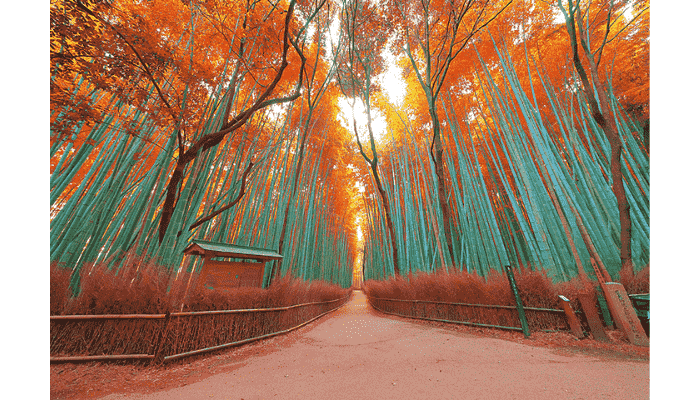
Since it’s such a popular destination, you’ll likely find it difficult to snap a photo without other visitors in the frame. Still, with a bit of patience, it’s worth slowly walking the short trail with your camera ready—the entire path is a photo opportunity.
When I visited, a light rain was falling. Thanks to the weather, the crowd was smaller, making the experience more serene and enjoyable.
If you’re hoping to enjoy the Bamboo Grove in quiet, consider going early in the morning or on a rainy day.
Bamboo Grove Path
- Address: Arashiyama, Ukyo-ku, Kyoto, Japan
- Map: [Google Maps]
- Access:
- ・10-minute walk from Randen Arashiyama Station or JR Saga-Arashiyama Station
- ・15-minute walk from Hankyu Arashiyama Station
- Phone: 075-861-0012 (Arashiyama Preservation Society)
- Closed: Open year-round
- Hours: Open for walking at any time
- Admission: Free
4. Kiyomizu-dera Temple – Enjoy Breathtaking Views of Kyoto

Kyoto is full of must-visit sights, but one that consistently ranks at the top of any popularity list is Kiyomizu-dera Temple.
Affectionately known by locals as “Kiyomizu-san,” this historic temple is beloved for its beauty, cultural significance, and breathtaking views.
Kiyomizu-dera has a long and storied history—it was originally founded in 778, and officially established in 780 by Sakanoue no Tamuramaro, a general known for his campaigns in northern Japan.

The temple’s name, Kiyomizu, meaning “pure water,” comes from a waka poem by Tamuramaro that refers to the crystal-clear waters of Otowa Waterfall, located on the temple grounds:
“Matsukaze ya, Otowa no taki no kiyomizu o, musubu kokoro wa, suzushikaruran”
(“The wind in the pines, the pure water of Otowa’s waterfall—may the heart that draws it remain pure and cool.”)
Unfortunately, the temple has been destroyed by fire multiple times throughout its long history.
The current Main Hall (Hondo) was rebuilt in the Edo period by order of Tokugawa Iemitsu, the third shogun of the Tokugawa family, and has stood for nearly 400 years—a remarkable feat in itself.

Perhaps the most iconic part of Kiyomizu-dera is the famous wooden stage, known as “Kiyomizu no Butai”, which juts out dramatically from the Main Hall.
This architectural marvel was built entirely without nails, supported by 168 towering wooden pillars and beams. It’s a powerful example of traditional Japanese craftsmanship and ingenuity.
Kiyomizu-dera Temple
- Address: 1-294 Kiyomizu, Higashiyama-ku, Kyoto
- Map: [Google Maps]
- Access:
・About a 10-minute walk from Gojozaka Bus Stop (Kyoto City Bus #100 or #206) - Phone: 075-551-1234
- Closed: Open year-round
- Hours:
・6:00 AM – 6:00 PM (closes at 6:30 PM in July and August)
・Special night illuminations (Spring, Summer, Autumn): Entry until 9:00 PM - Admission:
・Adults and high school students: ¥400
・Elementary and junior high students: ¥200
(Same pricing applies for night illuminations) - Official Website: Kiyomizu-dera Temple
5. Yasaka Shrine – Kyoto’s Beloved “Gion-san”
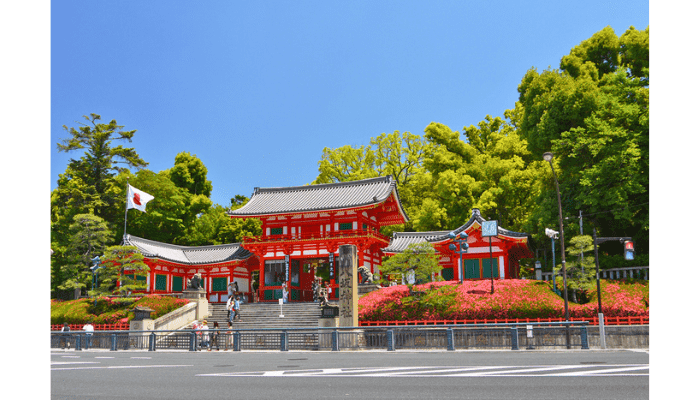
Known affectionately by locals as “Gion-san,” Yasaka Shrine is one of Kyoto’s most iconic landmarks and a beloved spiritual center in the city.
Every year during the first three days of the New Year, Yasaka Shrine welcomes around one million visitors for hatsumode (the first shrine visit of the year), making it the second most popular destination for New Year’s worship in Kyoto Prefecture—right after Fushimi Inari Taisha.

Yasaka Shrine is also the heart of the Gion Matsuri, one of Japan’s three great festivals.
Held throughout the entire month of July, this historic festival features a wide array of events, with the highlight being the spectacular Yamaboko Junko (float processions) on July 17 and 24.
In 2016, the Gion Matsuri’s float processions were officially registered as UNESCO Intangible Cultural Heritage, recognized under the title “Yamahoko Procession of Kyoto’s Gion Festival.”

One of the shrine’s more recent points of interest is the Utsukushi Gozen-sha (Beauty Shrine), located just to the right of the main hall.
In front of this small shrine flows a sacred spring, said to be “beauty water.”
It’s believed that applying a few drops to your skin can enhance not only your outer beauty, but also purify your heart—a unique kind of spiritual and physical blessing.
Kyoto is a beautiful city in every season, from cherry blossoms in spring to colorful foliage in autumn.
But if you’re looking for a truly unforgettable experience, the Gion Festival in July is a must-see—despite the sweltering heat and crowds.
The energy, tradition, and atmosphere make it one of Kyoto’s most exhilarating events.
Yasaka Shrine (Kyoto)
- Address: 625 Gionmachi Kitagawa, Higashiyama-ku, Kyoto
- Map: [Google Maps]
- Access: 5-minute walk from Keihan Gion-Shijo Station
- Phone: 075-561-6155
- Closed: Open year-round
- Hours:
・Shrine grounds open 24 hours
・Office hours (Shamusho): 9:00 AM – 5:00 PM - Official Website: Yasaka Shrine
6. Nijo Castle – Step into the World of the Samurai

Step into samurai history at Nijo Castle. Explore beautiful gardens and impressive interiors, including the famous “nightingale floors” that chirp when walked upon.
Unlike many of Kyoto’s temples and shrines, Nijo Castle is relatively new—it was built in 1603.
Originally, it served as a residence for shoguns when they visited Kyoto and as a base to protect the Imperial Court.
In today’s terms, you could say it was a shogun-operated luxury hotel in Kyoto.
The castle reached its current impressive scale during the rule of the third Tokugawa shogun, Iemitsu.
Nijo Castle (Kyoto)
- Address: 541 Nijojocho, Nakagyo-ku, Kyoto
- Map: [Google Maps]
- Access: Right in front of Nijojo-mae Station (Kyoto City Subway)
- Phone: 075-841-0096
- Closed: Year-end holidays, and Tuesdays in January, July, August, and December
- Hours:
・Entry: 8:45 AM – 4:00 PM
・Closing time: 5:00 PM
・Last admission to Ninomaru Palace: 4:10 PM - Admission Fees:
・Adults: ¥800 (¥1,300 including Ninomaru Palace admission)
・Middle/High School Students: ¥400
・Elementary School Students: ¥300
(Students under high school age can view the Ninomaru Palace at no extra cost) - Official Website: Nijo Castle
7. Scenic Sagano Romantic Train – Feel the Breeze

The Sagano Romantic Train (Torokko Ressha) is a beloved sightseeing train that runs year-round through some of Kyoto’s most breathtaking natural scenery. All seats are reserved and non-smoking, so be sure to plan ahead!
Before your trip, check the official website for seat availability. Tickets go on sale one month in advance, and since this is a very popular attraction, it’s best to book early—waiting too long might mean missing out on a seat.

This train is all about the journey, not the speed—it travels at a leisurely pace of around 25 km/h (15 mph). That slow speed, combined with the unique swaying motion of the open-air carriages, makes for a relaxing and immersive experience.
Thanks to the large windows, you can soak in the scenic views without even standing up.
Each season offers its own charm:
- Spring: Cherry blossoms and petals fluttering in the wind
- Summer: Lush green leaves and a refreshing breeze
- Autumn: Brilliant reds and golds of changing leaves

The Sagano Romantic Train operates between Saga Station and Kameoka Station, passing through iconic locations like Arashiyama and Hozukyo Gorge. Each segment of the route offers unique views, so consider your travel itinerary when booking your ticket.
One popular feature is the “Rich Car”—an open-air observation carriage that offers an even more dynamic view of the landscape. Tickets for the Rich Car are only available on the day of travel, and often sell out quickly, especially during peak seasons. If you’re interested, be sure to stop by the ticket booth early!
Sagano Romantic Train
- Location: Torokko Saga Station, Tenryuji Kurumamichi-cho, Ukyo-ku, Kyoto
- Map: [Google Maps]
- Access: Adjacent to JR Saga-Arashiyama Station (Sagano Line)
- Phone: 075-861-8511 (Sagano Sightseeing Railway Co., Ltd.)
- Closed:
- Wednesdays (except during spring break, Golden Week, summer holidays, and autumn foliage season)
- Also closed from Dec 30 to the end of February
- ※ Check the official website for special train schedules
- Operating Hours:
- Outbound (Saga → Kameoka): First train 10:02 / Last train 16:02
- Inbound (Kameoka → Saga): First train 10:30 / Last train 16:30
※ Special trains may operate—check the official website for the latest info
- Fare:
- Adults: ¥880 (one-way)
- Children under 12: ¥440 (one-way)
※ All seats are reserved
- Official Website: Sagano Romantic Train
8. Kyoto Imperial Palace – Visit the Former Home of Emperors
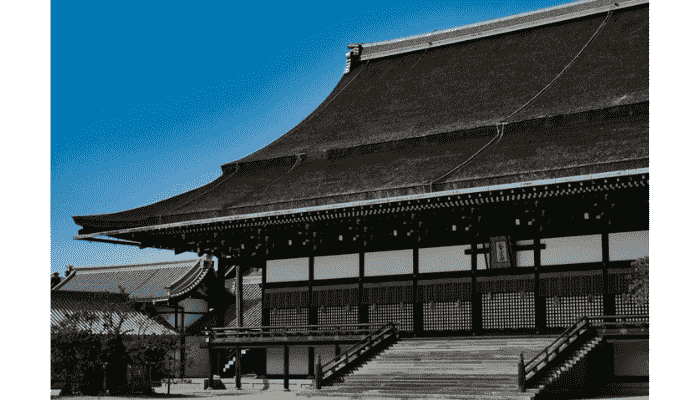
Some of Kyoto’s sightseeing spots can be a little harder to access—and the Kyoto Imperial Palace is one of them.
However, for those who make the trip, it offers a truly special glimpse into Japan’s imperial history.
Once requiring advance reservations, the Kyoto Imperial Palace is now open to the public year-round with no prior booking required (as of 2023).
That said, please note that the palace is closed on Mondays (or the following day if Monday is a national holiday), as well as during the New Year period and when official events are taking place.

This majestic palace was once home to Japan’s emperors, and walking through the grounds, you can almost feel the weight of history.
The site is impressively spacious—250 meters wide and 450 meters long—and early in the morning, you might see locals jogging through the peaceful grounds.
The current buildings were reconstructed in 1855 during the Edo period, and some parts have been restored in a style reminiscent of the Heian era, adding to the sense of stepping back in time.
Knowing that emperors once lived here adds a deep sense of significance to your visit.
If your travel schedule allows, this is definitely a site worth experiencing in person.
Kyoto Imperial Palace
- Address: 3 Kyoto Gyoen, Kamigyo-ku, Kyoto City, Kyoto Prefecture
- Map: [Google Maps]
- Access: 5-minute walk from Imadegawa Station (Kyoto Subway)
- Closed: Mondays (or the following day if Monday is a public holiday), New Year period, and days when official events are held
- Opening Hours:
- April – August: 9:00 AM – 5:00 PM (last entry at 4:20 PM)
- October – February: 9:00 AM – 4:00 PM (last entry at 3:20 PM)
- September & March: 9:00 AM – 4:30 PM (last entry at 3:50 PM)
- Admission: Free
- Official Website: Kyoto Imperial Palace
9. Tō-ji Temple – Home to Kyoto’s Iconic Five-Story Pagoda

When people think of Kyoto souvenirs, they often picture the iconic five-story pagoda—and most likely, it’s the one from Tō-ji Temple.
This pagoda was once the tallest building in Japan when it was built, and it remains one of Kyoto’s most recognizable landmarks.
In fact, there are four five-story pagodas in Kyoto: at Tō-ji in Minami Ward, Ninna-ji in Ukyo Ward, Daigo-ji in Fushimi Ward, and Hōkan-ji in Higashiyama Ward.
Among them, Tō-ji’s pagoda is the most famous and frequently photographed.
Tō-ji is designated as a UNESCO World Heritage Site and is home to one of the most breathtaking Buddhist halls in Kyoto: the Lecture Hall, where 21 statues form a three-dimensional mandala centered around the Dainichi Nyorai (Cosmic Buddha). The arrangement is visually striking and spiritually powerful.

Tō-ji also holds a unique place in history as the only remaining structure from the original Heian capital (Heian-kyō), standing since its founding over 1,200 years ago.
The temple was established as a state-sponsored Buddhist temple when the capital was moved to Kyoto in the late 8th century. Later, it was entrusted to the monk Kūkai (also known as Kōbō Daishi), who had returned from China after studying esoteric Buddhism.
Under Kūkai’s guidance, Tō-ji became Japan’s first temple dedicated to esoteric (Shingon) Buddhism.
Kūkai lived in the Mieidō Hall, and visitors today can still explore this sacred space to gain insight into his life and teachings.
Tō-ji Temple
- Address: 1 Kujō-cho, Minami-ku, Kyoto, Kyoto Prefecture
- Map: [Google Maps]
- Access: 10-minute walk from Tōji Station (Kintetsu Line)
- Phone: 075-691-3325
- Closed: Open year-round (no regular holidays)
- Opening Hours:
- Temple Grounds: 5:00 AM – 5:00 PM
- Main Hall (Kondō) & Lecture Hall (Kōdō): 8:00 AM – 5:00 PM (last entry 4:30 PM)
- Treasure Hall & Kanchiin Temple: 9:00 AM – 5:00 PM (last entry 4:30 PM)
- Special Night Admission: 6:00 PM – 9:30 PM (last entry 9:00 PM) Day and night visits are separate
- Admission Fees:
- Mieidō Hall, Dining Hall, etc.: Free
- Main Hall, Lecture Hall, Pagoda:
- Adults: ¥800
- High School Students: ¥700
- Children (Middle School & younger): ¥500
- Special Night Admission:
- Adults: ¥1,000
- Children: ¥500
- Note: Photography is not allowed inside the Main Hall and Lecture Hall.
- Official Website: Tō-ji Temple (Japanese site; some English info available)
10. Heian Shrine – Stroll Through Kyoto’s Beautiful Gardens

Located in Kyoto’s Sakyo Ward, Heian Shrine was built in 1895 to commemorate the 1,100th anniversary of the founding of the ancient capital, Heian-kyō (present-day Kyoto). The shrine is dedicated to Emperor Kanmu, who originally moved the capital to Kyoto in 794.
At the time of its construction, Kyoto had fallen into decline due to the turmoil of the late Edo period and the relocation of the capital to Tokyo. Heian Shrine was established as part of a major revitalization effort—to revive the spirit of Kyoto and reconnect the city with its imperial past.
One of Heian Shrine’s highlights is its sprawling garden (Shin’en), which is known for its seasonal beauty. Throughout the year, the gardens bloom with a variety of flowers, but spring is especially stunning. Over 20 types of cherry blossoms, including graceful weeping cherry trees (yae-shidare-zakura), paint the landscape in soft pink hues, attracting visitors from all over Japan and beyond.

The shrine buildings themselves are a 5/8-scale reconstruction of the original imperial palace (Chōdō-in and Daigokuden) from the Heian era, offering visitors a chance to step back in time to Kyoto’s ancient capital.
Interestingly, during the initial construction, there were some challenges with land acquisition, which led to minor changes in layout—such as the slightly altered position of the Suzaku Gate (the main entrance). Still, the majestic recreation of Heian-kyō’s palace complex is a rare and fascinating sight.
If you’re visiting Kyoto, Heian Shrine offers a blend of cultural significance, historical architecture, and natural beauty—all in one place. It’s a must-see destination for anyone wanting to experience Kyoto’s past and present.
Heian Shrine
- Address: 97 Nishitenno-cho, Okazaki, Sakyo-ku, Kyoto
- Map: [Google Maps]
- Access:
- 5-minute walk from “Okazaki Park / Bijutsukan / Heian Jingu-mae” bus stop (Kyoto City Bus No. 5, Raku Bus No. 100/110)
- 10-minute walk from Higashiyama Station (Kyoto Subway Tozai Line)
- Phone: 075-761-0221
- Closed: Open year-round
- Opening Hours
- Shrine Grounds:
- March 15 – September 30: 6:00 AM – 6:00 PM
- October & February 15 – March 14: until 5:30 PM
- November – February 14: until 5:00 PM
- Garden (Shin’en):
- March 15 – September 30: 8:30 AM – 6:00 PM
- October: 8:30 AM – 5:30 PM
- November – February: 8:30 AM – 5:00 PM
- Shrine Grounds:
- Admission
- Shrine Grounds: Free
- Garden (Shin’en):
- Adults: ¥600
- Children: ¥300
- Official Website: Heian Shrine
How to Get Around Kyoto
Getting around Kyoto is easy with buses and trains. An IC card like Suica or ICOCA makes traveling even smoother.
For sightseeing areas like Higashiyama, Gion, and Arashiyama, walking is highly recommended to fully enjoy the scenery.
Where to Stay
For first-time visitors, staying in these areas is ideal:
- Downtown Kyoto (Kawaramachi, Shijo area): Convenient for shopping, dining, and transportation.
- Gion/Higashiyama area: Perfect if you want to stay surrounded by traditional Kyoto vibes.
Sample 2-Day Itinerary
Day 1 – Discover Historic Kyoto (Higashiyama & Gion)
| Time | Spot | What to Do |
|---|---|---|
| 9:00 | Kiyomizu-dera Temple | Start your day with panoramic views and explore the famous wooden stage. (1–1.5 hrs) |
| 10:30 | Sannenzaka & Ninenzaka | Walk down charming streets lined with shops and cafes. (30 mins–1 hr) |
| 11:30 | Yasaka Shrine | Visit this iconic shrine connecting to Gion. (30 mins) |
| 12:00 | Lunch in Gion | Enjoy Kyoto cuisine or light bites like yuba, soba, or matcha sweets. (1 hr) |
| 13:30 | Kennin-ji Temple | Explore Kyoto’s oldest Zen temple. (30–45 mins) |
| 14:30 | Gion District Walk | Stroll Hanamikoji Street; you may spot a geisha! (1 hr) |
| 16:00 | Maruyama Park or Chion-in | Relax or explore another temple before sunset. (30 mins–1 hr) |
| Evening | Pontocho Alley | Have dinner by the riverside. Great for first-timers! (Flexible) |
Day 2 – Nature & Iconic Views (Arashiyama + City North)
| Time | Spot | What to Do |
|---|---|---|
| 9:00 | Arashiyama Bamboo Grove | Start early to avoid crowds and enjoy the magical bamboo path. (30 mins) |
| 9:45 | Tenryu-ji Temple | Visit this UNESCO Zen temple with a beautiful garden. (1 hr) |
| 11:00 | Togetsukyo Bridge + Riverside Walk | Scenic photos and optional boat ride. (30 mins–1 hr) |
| 12:00 | Lunch in Arashiyama | Try tofu dishes or yudofu near the river. (1 hr) |
| 13:30 | Travel to Kinkaku-ji | Take JR or bus. (30–40 mins travel time) |
| 14:15 | Kinkaku-ji (Golden Pavilion) | Admire the glittering golden temple. (45 mins–1 hr) |
| 15:30 | Nijo Castle | Finish with a historic castle and its gardens. (1 hr) |
| 17:00 | Kyoto Station / Shopping | Relax, shop for souvenirs, or grab an early dinner. (Flexible) |
Tips:
- Use a Kyoto Bus/Metro Day Pass if possible.
- Avoid weekends and holidays for smoother travel.
- Wear comfortable shoes—there’s plenty of walking!
Final Tips for First-Time Visitors
- Best seasons to visit: Spring (cherry blossoms) and Autumn (fall foliage).
- What to wear: Comfortable shoes are a must — you’ll walk a lot!
- Timing: Start sightseeing early to avoid crowds, especially at popular spots like Fushimi Inari and Arashiyama.
Frequently Asked Questions (FAQ)
Q1: What is the best time to visit Kyoto for first-time travelers?
A: Spring (March to April) and autumn (October to November) are the best seasons, thanks to cherry blossoms and fall foliage. These times offer the most beautiful scenery and pleasant weather.
Q2: How many days should I stay in Kyoto?
A: Two to three days are ideal for beginners. This gives you enough time to explore major sights like Fushimi Inari, Arashiyama, and Kiyomizu-dera without rushing.
Q3: Is Kyoto walkable?
A: Yes, especially areas like Gion, Higashiyama, and Arashiyama. However, public transportation (bus, subway, JR lines) is essential for visiting distant places like Kinkaku-ji or Fushimi Inari.
Q4: What should I wear in Kyoto?
A: Wear comfortable walking shoes. Kyoto involves a lot of walking and temple steps. In spring/autumn, layers are best; summer is hot and humid, while winter can be chilly.
Q5: Do I need to know Japanese to travel in Kyoto?
A: Not at all. Many signs are in English, and most major tourist spots have English-speaking staff or guides. However, learning basic greetings or thank-yous is appreciated!
